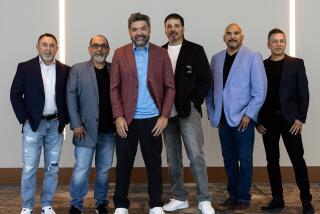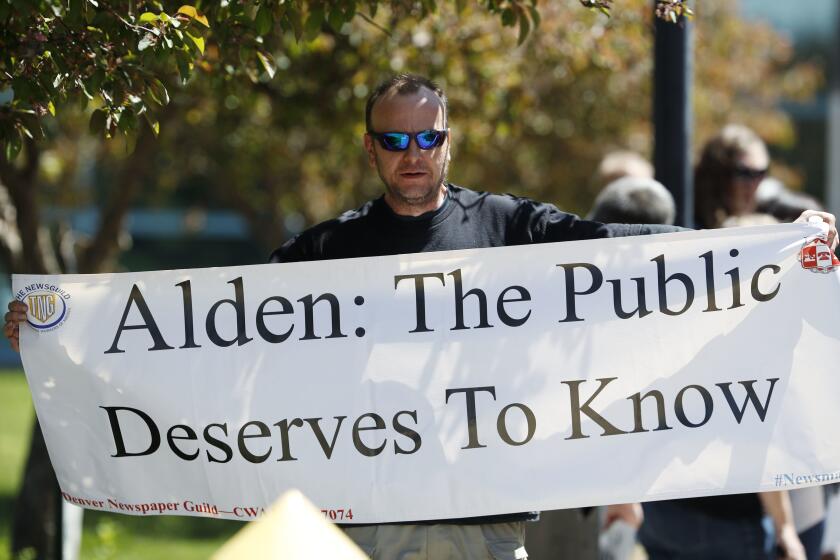There’s something funny about big band leader John Hollenbeck
Even if you haven’t heard the John Hollenbeck Large Ensemble, you might think you have its sound pegged. It’s an 18-piece big band, after all, one that’s twice been nominated for a Grammy in the jazz category, most recently for its acclaimed 2009 album “Eternal Interlude.”
But jazz fans coming to the group’s show at REDCAT Monday night looking for the familiar structures of, say, last month’s performance at Walt Disney Concert Hall by the Jazz at Lincoln Center Orchestra might be surprised. Co-leader and drummer for the Claudia Quintet, Hollenbeck pulled the ensemble together in New York City some 10 years ago as a response to some of his big band experiences.
“I saw some things that could be done that weren’t being done,” Hollenbeck said by phone from New York days before the ensemble began its first West Coast tour. “I thought there might be some other possibilities with a group that still has traditional instrumentation but the music itself is not traditional.”
Under Hollenbeck’s lead, the Large Ensemble’s songs can carry a cinematic drive or ebb and flow with the elliptical grace of modern classical music. Batteries of brass circulate in taut bunches, churning like steam engines or delicately mingling with piano, percussion and otherworldly vocals in pieces that can stretch to almost 20 minutes but never lose forward momentum. Improvisation is present, but treated like a scarce resource.
It’s a philosophy Hollenbeck attributes to years studying with Bob Brookmeyer, a boundary-pushing composer and valve trombonist who has worked with an array of jazz royalty including Stan Getz and Gerry Mulligan. Hollenbeck played drums for Brookmeyer’s New Art Orchestra, and his work with the Large Ensemble reflects the veteran bandleader’s economical view of soloing.
“Many times I feel like improvisation is a little self-centered, and a little more fun for the musicians than the audience,” Hollenbeck says. Brookmeyer “was probably the most important person who basically said there doesn’t have to be improvisation, and if there is improvisation it has to come at the right moment and for the right reasons.”
Which isn’t to say that Hollenbeck is a musical conservative. Living in Germany while teaching at the Jazz Institute Berlin, Hollenbeck keeps busy composing and working with artists such as Meredith Monk, Theo Bleckmann and the eclectic Claudia Quintet, which retains a looser attitude toward improvisation. Also influenced by Schoenberg’s 12-tone music and György Ligeti as well as electronic artists such as Boards of Canada, Hollenbeck appreciates how difficult his work is to classify.
“That would be the furthest thing from my mind — is this jazz or, ‘What is it?’ ” he said. “I’m more on the other side, more looking for something I haven’t heard before … For me that’s kind of what I thought jazz is about, the forward motion and kind of music that you couldn’t really get a handle on.”
Another side of Hollenbeck that defies expectation is his sense of humor. Generally reserved in conversation, Hollenbeck’s wit comes forward in wryly sharing experiences at last year’s Grammys (he never found the red carpet) or joining the Internet’s chorus of year-end lists with a straight-faced “Best Toilets of 2010” photo essay on a blog hosted by the Bad Plus’ Ethan Iverson. Though Hollenbeck stresses he’s not kidding around musically, there is a method to his lighthearted approach.
“I think a lot of people who aren’t familiar with this type of music think it’s very serious and very intellectual. Humor is one way to let them know that it’s not just that,” he said. “These are normal guys and they’re funny and laugh about stuff, and that can help draw people in. Then once they get in, it’s no problem.”
More to Read
The biggest entertainment stories
Get our big stories about Hollywood, film, television, music, arts, culture and more right in your inbox as soon as they publish.
You may occasionally receive promotional content from the Los Angeles Times.











